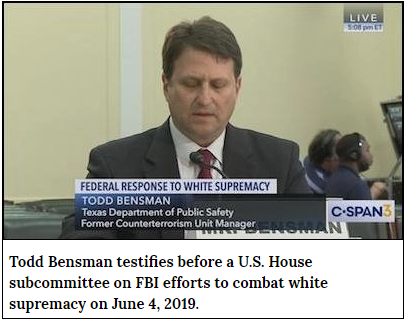After the El Paso massacre, a narrative is emerging that America has fought Islamic extremism too hard, leaving white supremacists to flower. The Democrat narrative that President Trump suppressed national investigative efforts that would hurt his friends and supporters in the white supremacy movement is flat-out false.
By Todd Bensman as originally published August 6, 2019 in The Federalist
AUSTIN, Texas — Earlier this summer, I testified before a U.S. House subcommittee on “FBI efforts to combat an increasing threat of white supremacy and white extremism.” My expertise is that of a former counterterrorism intelligence manager for the Texas Department of Public Safety, where for nearly a decade (2009-2018) my team of analysts worked on domestic and international terrorism matters with the FBI as part of one of the nation’s largest multi-agency fusion centers.
The House Democrats of the Oversight and Reform Committee came to the hearing with a narrative: that white nationalist President Donald Trump had suppressed national investigative efforts that would hurt his friends and supporters in the white supremacy movement.
I testified to a contrary experience in Texas coordinating intelligence with our state criminal investigative agents, who were assigned to all five of the state’s FBI Joint Terrorism Task Forces, usually to domestic terrorism squads working on problems that included violent white supremacy, black identity nationalism, and the anarchist Antifa movement.

“Neither we nor the FBI ever dismissed the domestic extremist threat or violent white supremacists, as some suggest, but faced them at every turn during my service,” I testified, in part. “I personally saw to it that some of my analysts were always dedicated to this threat problem. What I can tell you from my experience is that our collaborative arrangements remained in place after the 2016 election. At the line level, we created intelligence, passed information to the FBI on the e-Guardian system or in person, and filled their requests for their case needs. Good things happened as a result.”
I stand by that. In the aftermath of this past weekend’s mass shootings, another form of the narrative is finding purchase: that strong post-9/11 efforts to counter Islamist terrorism are politically and racially inequitable compared to the weak, suppressed efforts to counter violent white nationalism.
As the editorial board of The New York Times put it Sunday, “There are serious questions about how the United States has approached Islamic extremism, but if even a degree of that vigilance and unity of effort was put toward white nationalism, we’d be safer.”
Assessments like this belie a surprising ignorance of the fact that homeland security legislation, appropriations, and response were structured after 9/11 to address problem sets that are so mutually exclusive that they have and always will require separate approaches. This is the very definition of a false comparison that should stand corrected as the nation lurches forward in any public discussion. It cannot be farther from true that violent Islam received a disproportionate attention at the high cost of allowing domestic forms of violent extremism to flourish.
Take the Islamist threat. Because violent political Islamism emanates from a global, internationalist set of actors and ideologies, often in foreign locales, a multi-piece toolkit was required to help the FBI counter it as the designated lead agency. Unlike forms of domestic extremism, working to disrupt Islamist terrorism requires both a deep home and away game. The FBI cannot do it without CIA spies, National Security Agency signals intelligence operations, troop deployments, armed drones, and global tracking of human suspects and money.
Consider what it might take to counter al-Qaeda plans to send operatives from Afghan training camps to hijack planes in America, or to disrupt ISIS operatives moving across multiple borders on mass-casualty attack missions in Europe, or to counter the highly effective online recruitment of Americans who travel abroad and join foreign groups of killers in foreign countries with plans to return home, perhaps indoctrinated to commit acts of terror. Legislation and vast inter-agency intelligence-sharing reforms after 9/11 were necessary to marry this very unique American response to an equally unique threat.
By contrast, violent white supremacy of the sort we saw on tragic display in El Paso is largely a law enforcement problem confined to within the United States and its territories, with far less of a global dimension. While a shooter may take “inspiration” from manifestos and chatter posted online or acts seen on the news, like the mosque massacre in Christchurch, New Zealand, these kinds of crimes and plots tend to be entirely local self-propelled affairs conducted by lone offenders.
Much has been said, for instance, about the online format “8chan” as a platform for spreading incitements to violence among white racist extremists (the site has been closed since El Paso). But law enforcement agencies already have the means to watch sites like this, and other sites that traffic in narcotics and stolen property, for that tricky moment when free speech becomes illegal incitement or provides probable cause indicators.
Lone offender racists in the United States are not deployed from places abroad that must be controlled and monitored as with international jihadist terrorism. For that reason, domestic terrorism plots require an almost exclusively domestic law enforcement response by the FBI, local sheriff’s offices, and state police agencies like the one I used to work for in Texas.

CIA officers and military forces are not even statutorily allowed to operate in a law enforcement capacity within U.S. territory, nor can the NSA, spy satellites, or armed drones be enjoined in domestic enforcement action next to your local sheriff’s deputy. The USA Patriot Act did formalize a domestic terrorism definition (another of many) and allow for the FBI and DHS to identify potentially violent domestic groups and movements as intelligence and enforcement priorities, at least internally. Domestic extremists to include violent white nationalists can be placed on terror watch lists as a means to occasionally track their movements and activities.
But not much new legislation, such as a standalone Domestic Terrorism Statute, was ever necessary to mount a counterattack on violent white nationalism, since all of the necessary component parts—cops, prosecutors, and criminal statutes that carry high punishments, such as for murder and hate crimes—have long been in place.
Critics of President Trump may feel a strong compulsion to argue that his excess hatred of Islam and affection for white supremacy drove policy toward a break for the white nationalists. But their thinking is flawed by gaps in basic knowledge of how homeland security is structured to deal with both problems in the unique ways that are necessary.
This is not to say that American law enforcement can’t pivot to meet a growing threat with greater resources and attention. As I testified to Congress in June, “The number of racially motivated criminal events is now higher than what we were used to. A pivot is necessary to reverse the trend.”
However, inequality of effort certainly did not contribute to El Paso. Self-propelled lone offenders who use simple tactics in their attacks are notoriously difficult for law enforcement to detect, or to detect in time to lawfully intervene.
The threat from violent Islamism remains in play, despite other faulty comparisons that are often made to fraudulently downplay it, such as the current favorite of comparing the death toll from Islamist-motivated attacks to those caused by domestic supremacists. Properly diagnosing threats requires not death tolls but reporting the total numbers of thwarted attacks that might have resulted in deaths. And the FBI has tallied hundreds of prosecutions related to the Islamist terror threat.
To divert from efforts to disrupt Islamist attacks by the hundreds no doubt will result in lost lives one day, as it did before 9/11. In any case, whether to prioritize violent Islamism or white nationalism is not an either-or proposition. This is a resourced country that certainly can and should do both jobs separately and well.